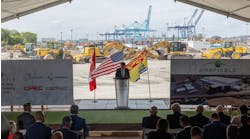Vancouver Island presents a special challenge to food processors and distributors. It is big enough to be self-sufficient in many ways, but still needs support from the outside. Nowhere is this more evident than in the carriage and distribution of frozen and perishable foods, says Kelly Hawes, president of ColdStar Freight Systems in Victoria, British Columbia.
Food processors go to great lengths to produce high-quality goods in pristine plants, he says. At destination, food is handled with care to preserve quality and condition until final sale. Until recently, the weak point in the supply chain for residents of Vancouver Island was movement of goods across the Strait of Georgia from the mainland. Although frozen and perishables were handled under refrigeration, for-hire distribution lacked the same intense level of quality control available at processing plants and at retail outlets, Hawes says.
The missing link was public refrigerated cold storage with its own distribution capability to ensure total quality control from the point of shipment through consolidation and handling to final delivery. “We knew that the first to offer such a complete package would have a head start on the rush into high-quality distribution of perishables that would surely follow,” Hawes says.
Explosive early growth
His prediction has proved correct. Cold Star Freight Systems started January 31, 2000, with a single truck and 2,000 sq ft of cooler built by Hawes inside leased dock space. Within three weeks, the company had to add a second truck. After only eight weeks, demand for service was so strong that the fleet numbered six trucks.
The warehousing and distribution envisioned by Hawes is now a reality, based on the partnership of two separate companies — ColdStar, the carrier, and Minus 28, the warehouse. ColdStar is owned by Hawes and operates from the same building as Minus 28. Mick Farup and Todd Harmon, two local businessmen who bought into Hawes' concept of integrated warehousing and distribution, own Minus 28. ColdStar has 9,000 sq ft of refrigerated dock space and seven loading doors. The combined facility covers 35,000 sq ft, and Minus 28 has 10 loading doors in its 26,000 sq ft. With 35-ft ceilings, the building holds 3,000 pallet positions on the Minus 28 side alone.
The two companies work cooperatively. Some inbound freight moved by ColdStar goes into long-term storage at Minus 28. At the same time, Minus 28 pulls orders from storage for cross-dock delivery by ColdStar.
Say the name “Vancouver” and most listeners picture the bustling city on the southwest coast of British Columbia. However, the name of the British explorer and sea captain, a subordinate of Captain Cook, also is attached to the largest island along the West Coast of North America. It is an island that can be supplied only by sea or air; although, from time to time government or commercial interests propose building a bridge across the strait where it narrows to only 15 miles. Such a project would be complicated by the fact that the water is extremely deep and the strait experiences severe storms in winter.
Heavily populated island
The importance of Vancouver Island in British Columbia is both economic and political. Almost 80% of the total provincial population of 4.1 million resides in the southwestern corner of British Columbia that includes the island and the city of Vancouver and its suburbs, an area known as the Lower Mainland. Population of the island is almost 700,000, and more than half that is in greater Victoria. Perhaps most important, Victoria is the provincial capital.
Vancouver Island is quite large, ranging 285 miles in length north to south and 50 miles wide for most of that length. The majority of the population is concentrated on the southern half from Campbell River down to Victoria. A road trip from Victoria to Port Hardy on the north end takes more than seven hours. Most of the population outside Victoria lives along the island's eastern shore. Vancouver Island has only two communities of any size directly on the Pacific plus Port Alberni at the head of one of the many fjords that cut into the landscape from the ocean. At the extreme southern end, Victoria sits well south of the 49th parallel that serves as the border between Canada and the United States on the mainland.
With its own fleet or local contractors, ColdStar serves the entire island plus a number of the islands in the waters offshore. Campbell River is actually as far north as ColdStar sends its own equipment; contractors serve the northern half of Vancouver and the Gulf Islands. The run to Campbell River and back with a 48-ft trailer requires an average of 13 hours to complete.
Daily mainland pickups
Now that the ColdStar fleet has grown to eight tractors, 10 trailers, and 13 straight trucks, operations have settled into a predictable, if still somewhat hectic, pattern. Nearly all the tractors and trailers are sent to the mainland daily. Some freight crosses with them, but the primary purpose is to pick up shipments for receivers on the island. Trailers headed to the mainland are loaded only 30% of the time, Hawes says.
Island-bound trailers are stuffed full. In fact, ColdStar has an agreement with one truck operator on the mainland to pick up small shipments during the day for transfer to one of the trailers. If freight volume overwhelms ColdStar capacity on the mainland, an extra truck is dispatched in the afternoon to take on the overflow. “We always have a good picture of our daily volume by 4 pm,” Hawes says.
Most inbound freight moves in bulk to be sorted into individual deliveries on the ColdStar dock in Victoria. For instance, the company handles almost 90% of the fresh poultry sold on Vancouver Island including 100% of that used by Kentucky Fried Chicken restaurants. The company also handles all the holiday turkeys, which amounts to about 4 million pounds shipped during a five-week period.
Mainland shippers also tender store-ready shipments for cross-dock handling by ColdStar. The mix from day to day is about 50% bulk shipments and 50% cross-dock. In either case, ColdStar's service meets the absolute definition of just in time; some customers receive deliveries within six hours after processing is complete. ColdStar clears its dock nightly.
Pickup operations on the mainland look like just about those of any other distribution carrier. Trucks meet their appointments, take on freight, and go on to the next pickup spot. Load preparation and delivery has the same appearance. Freight is sorted into individual shipments by route and receiver. Trucks leave the terminal on a schedule designed to meet the delivery windows set by receivers. Some deliveries in the Victoria area begin as early as 2 am. For receivers farther north, delivery begins about 4 am. All delivery is complete by 1 pm.
Between pick-up and delivery, ColdStar operations take on an entirely different look, because the route from Vancouver to Victoria requires a one-hour, 35-minute trip by ferry. In summer months, BC Ferries has a sailing every hour from 7 am to 9 pm. In winter, the frequency is reduced to one sailing every two hours. A limited number of reservations are available for the ferries. If ColdStar has reservations, the equipment must appear at the ferry landing 30 minutes prior to sailing time. Without a reservation, a truck needs to be at the landing at least an hour before scheduled departure to have a reasonable chance of making the ferry.
Delivering on the island is relatively easy, but delivering to the island is a logistical nightmare, Hawes says. The first hurdle to clear is meeting the ferry schedule. After the ferry ride, equipment has another half-hour trip to the ColdStar terminal, which means that trucks on the last ferry of the night arrive just as load consolidation goes into full swing. The second obstacle is cost. Moving a tractor and trailer by ferry costs C$250 each way. “We spend more than C$1 million on ferries each year,” he says.
The US dollar has weakened recently. As a result, Canadian currency is worth about 75 cents on the dollar. In terms of the US dollar, ColdStar has a cost structure of $350 (C$500) for every trip regardless of how much freight is involved. This provides a compelling reason to search for additional freight bound from the island to the mainland.
To help offset this built-in cost, ColdStar has based its service on frozen and perishables only. “At rare intervals, we will take a shipment of dry freight,” Hawes says, “but we stress to the customer that the shipment will be handled in a refrigerated environment and that the price for dry freight is the same as that for refrigerated and that the shipment must be food product.”
Verifiable quality control
Quality control during distribution has been the selling point behind ColdStar from the beginning. To ensure that control and to provide verification to customers, the company has installed Thermo King's R:Com vehicle monitoring system on all trailers. Working with the data loggers in the SB-200 and SB-300 refrigeration units, ColdStar has a complete record of shipment condition throughout each trip. R:Com is a radio tool that downloads data from the data loggers when a trailer is interrogated by an antenna at the terminal. The system also provides yard management and alarms if trailer temperature goes out of the preset range.
Typically, refrigeration units are set at 28° F. “We never go above 35° F,” Hawes says. “Most importantly, shipments on ColdStar are never out of the cold chain, and with data loggers and R:Com, we can prove it.”
Metric nation
Even the refrigeration thermostat settings are a matter for careful monitoring. Canada is officially a metric nation, so many instructions for temperature control are given on the Celsius scale. However, not all shippers use Celsius. “We clarify the scale used for the temperature setting for each shipment with every shipper,” Hawes says.
ColdStar takes one additional step to ensure the quality and security of shipments. “We use the ferry for a reason,” Hawes says. “Barge service to the island is available, but that leaves the trailers unattended. On the ferry, our drivers stay with the equipment, so loads are never unsupervised. As security of the food chain gets more attention, we feel that this will gives us an added point of attraction to customers.”


